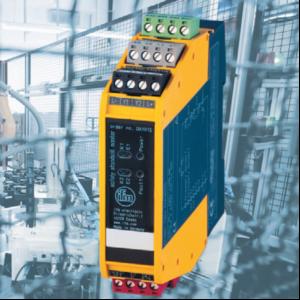

|
Edward Lowton
Editor |


|
| Home> | Health, Safety & Welfare | >Plant and machinery safety | >Zero speed safety relay |
ARTICLE
Zero speed safety relay
25 January 2013
Ensuring that a rotation or oscillation has ceased is critical if personnel need access to that part of a plant. Therefore, it is critical to select devices that will protect the workforce by ensuring that such motion,

Ensuring that a rotation or
oscillation has ceased is critical if
personnel need access to that part of
a plant. Therefore, it is critical to
select devices that will protect the
workforce by ensuring that such
motion, or lack of it, is detected in as
safe a manner as possible.
The new DA101S zero-speed safety relay from ifm electronic has been tested by TÃœVNord for use in applications up to and including PL e according to ISO 13849-1, SIL 3 according to IEC 61508 and SILClaim Limit 3 according to EN62061.
Equipped with two volt-free safety relay outputs, the slim housing of the DA101S measures just 25mm wide and has a solid-state PNP feedback output as well as LED indicators to verify the status of inputs and outputs.
As true zero motion is difficult or impossible to verify, the DA101S is set by the user to detect a low frequency, and switch when the detected pulse rate drops below the pre-set. This pre-set will vary according to the pick-up arrangement and machine constraints, so one of our frequencies (0.2, 0.5, 1 and 2Hz) can be selected using a hard-wired link that cannot be changed during operation without the unit switching into the safe state.
The new DA101S zero-speed safety relay from ifm electronic has been tested by TÃœVNord for use in applications up to and including PL e according to ISO 13849-1, SIL 3 according to IEC 61508 and SILClaim Limit 3 according to EN62061.
Equipped with two volt-free safety relay outputs, the slim housing of the DA101S measures just 25mm wide and has a solid-state PNP feedback output as well as LED indicators to verify the status of inputs and outputs.
As true zero motion is difficult or impossible to verify, the DA101S is set by the user to detect a low frequency, and switch when the detected pulse rate drops below the pre-set. This pre-set will vary according to the pick-up arrangement and machine constraints, so one of our frequencies (0.2, 0.5, 1 and 2Hz) can be selected using a hard-wired link that cannot be changed during operation without the unit switching into the safe state.
MORE FROM THIS COMPANY
OTHER ARTICLES IN THIS SECTION

















